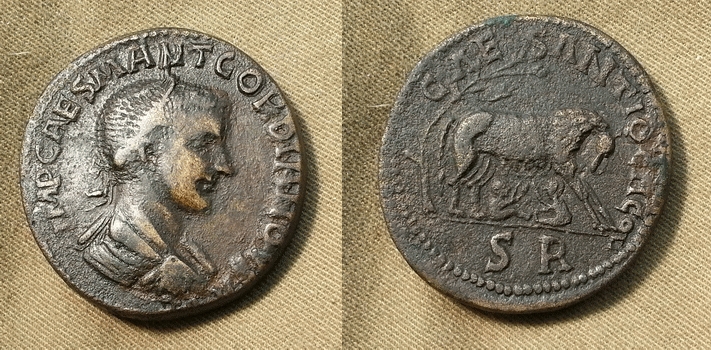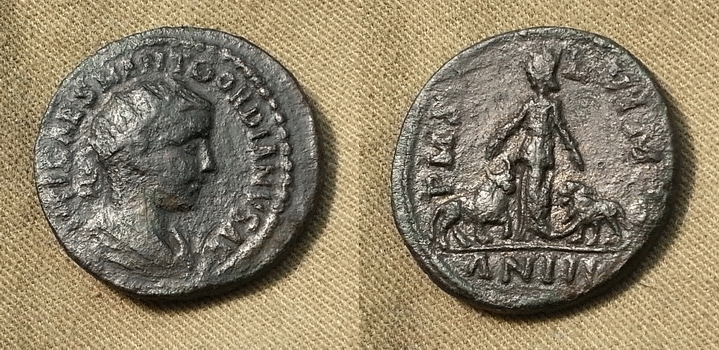
Gordian III AE 32mm of Pisidia, Antioch. 240-244 AD.
IMP CAES M ANT GORDIANVS AVG, laureate head right
CAES ANTIOCH COL, S R around and beneath she-wolf
right, suckling twins,
fig-tree behind.
SNG France 3 1198-1201; SNG von Aulock 4952; Krzy.
GOR10.49 SNG Cop 69v
(Variation of Referenced IDs)

Gordian III AE 24mm of Viminacium. Year 3 = 241/242
or 243
Obverse: AD. IMP CAES M ANT GORDIANVS AVG, radiate
draped bust right
Reverse: PMS COL VIM, Moesia standing between bull
and lion; AN III in exegue
AMNG 80, Moushmov 32
(Variation of AMNG 80s)
|
|
Gordian III (Latin: Marcus Antonius Gordianus Pius Augustus; 20 January
225 AD – 11 February 244 AD) was Roman Emperor from 238 AD to 244 AD.
At the age of 13, he became the youngest sole legal Roman emperor throughout
the existence of the united Roman Empire. Gordian was the son of
Antonia Gordiana and an unnamed Roman Senator who died before 238.
Antonia Gordiana was the daughter of Emperor Gordian I and younger sister
of Emperor Gordian II. Very little is known on his early life before
his acclamation. Gordian had assumed the name of his maternal grandfather
in 238 AD.
Rise to power:
In 235, following the murder of Emperor Alexander Severus in Moguntiacum
(modern Mainz), the capital of the Roman province Germania Inferior, Maximinus
Thrax was acclaimed Emperor. In the following years, there was a
growing opposition against Maximinus in the Roman senate and amongst the
majority of the population of Rome. In 238 a rebellion broke out
in the Africa Province, where Gordian's grandfather and uncle, Gordian
I and II, were proclaimed joint emperors. This revolt was suppressed
within a month by Cappellianus, governor of Numidia and a loyal supporter
of Maximinus Thrax. The elder Gordians died, but public opinion cherished
their memory as peace-loving and literate men, victims of Maximinus' oppression.
Meanwhile, Maximinus was on the verge of marching on Rome and the Senate
elected Pupienus and Balbinus as joint emperors. These senators were
not popular men and the population of Rome was still shocked by the elder
Gordian's fate, so that the Senate decided to take the teenager Gordian,
rename him Marcus Antonius Gordianus as his grandfather, and raise him
to the rank of Caesar and imperial heir. Pupienus and Balbinus defeated
Maximinus, mainly due to the defection of several legions, particularly
the II Parthica who assassinated Maximinus. But their joint reign
was doomed from the start with popular riots, military discontent and an
enormous fire that consumed Rome in June 238. On July 29, Pupienus
and Balbinus were killed by the Praetorian Guard and Gordian proclaimed
sole emperor.
Rule:
Due to Gordian's age, the imperial government was surrendered to the aristocratic
families, who controlled the affairs of Rome through the Senate.
In 240, Sabinianus revolted in the African province, but the situation
was quickly brought under control. In 241, Gordian was married to
Furia Sabinia Tranquillina, daughter of the newly appointed praetorian
prefect, Timesitheus. As chief of the Praetorian Guard and father in law
of the Emperor, Timesitheus quickly became the de facto ruler of the Roman
Empire.
In the 3rd century, the Roman frontiers weakened against the Germanic tribes
across the Rhine and Danube, and the Sassanid Empire across the Euphrates
increased its own attacks. When the Persians under Shapur I invaded
Mesopotamia, the young emperor opened the doors of the Temple of Janus
for the last time in Roman history, and sent a large army to the East.
The Sassanids were driven back over the Euphrates and defeated in the Battle
of Resaena (243). The campaign was a success and Gordian, who had
joined the army, was planning an invasion of the enemy's territory, when
his father-in-law died in unclear circumstances. Without Timesitheus,
the campaign, and the Emperor's security, were at risk.
Gaius Julius Priscus and, later on, his own brother Marcus Julius Philippus,
also known as Philip the Arab, stepped in at this moment as the new Praetorian
Prefects and the campaign proceeded. Around February 244, the Persians
fought back fiercely to halt the Roman advance to Ctesiphon. Persian
sources claim that a battle occurred (Battle of Misiche) near modern Fallujah
(Iraq) and resulted in a major Roman defeat and the death of Gordian III.
Roman sources do not mention this battle and suggest that Gordian died
far away from Misiche, at Zaitha (Qalat es Salihiyah) in northern Mesopotamia.
Modern scholarship is not unanimously accepting this course of the events.
One view holds that Gordian died at Zaitha, murdered by his frustrated
army, while the role of Philip is unknown. Other scholars, such as
Kettenhofen, Hartman and Winter have concluded that Gordian died in battle
against the Sassanids.
Philip transferred the body of the deceased emperor to Rome and arranged
for his deification. Gordian's youth and good nature, along with
the deaths of his grandfather and uncle and his own tragic fate at the
hands of the enemy, earned him the lasting esteem of the Romans.
The soldiers held Gordian in high esteem, as he may have sacrificed his
life to save them in 244.
Information was taken from Wikipedia, the free encyclopedia
at this URL:
https://en.wikipedia.org/wiki/Gordian_III
|